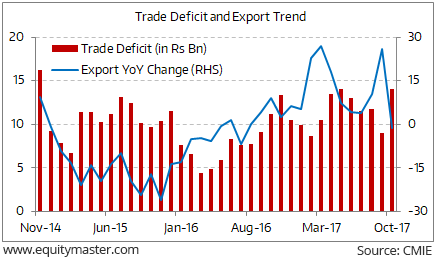- Home
- Todays Market
- Indian Stock Market News December 18, 2017
Indian Indices Stage Recovery as BJP Seen Securing Fifth Term in Gujarat; Sensex Up 230 Pts Mon, 18 Dec 11:30 am
After witnessing a sharp correction in early trade, Indian share markets have staged a recovery and are presently trading on a positive note.
Sectoral indices are trading on a positive note with stocks in the metal sector and auto sector witnessing maximum buying interest.
The BSE Sensex is trading up 220 points (up 0.7%) and the NSE Nifty is trading up 67 points (up 0.7%). The BSE Mid Cap index is trading up by 0.9%, while the BSE Small Cap index is trading up by 0.8%. The rupee is trading at 64.13 to the US dollar.
Market participants are closely tracking the vote count for Gujarat and Himachal Pradesh (HP) elections.
At the time of writing, data showed BJP leading Gujarat polls with over 100 seats. The same is the case in HP, where BJP is leading polls with 44 seats.
This was not the case earlier today when the opposition Congress was leading the vote count, with 85 seats. At that point in time, BJP was ahead only in 79 seats.
BJP needs a total of 92 seats to retain power in Gujarat and 35 seats to retain power in HP.
There are high stakes involved as the outcome of this election would determine the direction of the country's reforms and policies in the runup to the 2019 elections.
The outcome is also important for the Indian stock markets. As Ankit writes in one his editions of Equitymaster Insider..."stock market valuations in India seem to reflect what I call the 'Modi market premium'". You can read his entire note on this topic here (requires subscription).
The final vote count will be known within a few hours. We'll keep a close watch on the developments in this space and keep you updated. Stay tuned.
In the news from the macroeconomic front, India's exports rose at a faster clip in November.
As per the data released by the commerce department, exports grew 30.6% in November from a year ago.
Rising trend was also seen for imports, which rose 19.6% during the same period.
The above trend reversed the contraction in the previous month and allayed lingering concerns that the goods and services tax (GST) will dent shipments.
Note that India's goods export growth declined by -1.1% YoY in October this year to US$23 billion, the lowest pace of growth since - 6.86% in July 2016, as can be seen from the chart below:
Trade Deficit Widens, Exports Fall in October
The above decline was seen because exporters struggled with a liquidity crunch on the back of delayed refunds under the goods and services tax (GST) regime.
The fall was seen on the back of the impact of the GST on the export segment. Particularly micro, small and medium enterprises (MSMEs), were facing liquidity problems after paying GST for four months in a row without getting any refund.
While the rise in exports in November come as a welcome breather, it would be interesting to see how this trend unfolds in upcoming months.
In the news from the pharma space, as per an article in the Economic Times, audits of Indian drug manufacturing facilities by the US Food and Drug Administration (USFDA) are set to rise sharply after October's Mutual Recognition Agreement between the US regulator and eight European Union member states.
The above pact includes Sweden, Austria, Croatia, France, Italy, Malta and Spain. The agreement allows for recognition of each other's inspection outcomes and better use of expertise and resources by eliminating duplication.
Relying on inspections by EU regulators will allow USFDA to shift resources to other locations. However, the decision may benefit units with a consistently better track record with EU.
The above development adds to the existing regulations and price pressures the pharma industry has been facing from the US lately. Note that USFDA alerts on Indian pharma companies have increased over the past few years. Earlier, regulators used to visit the plants every two years. Now they come every eight months.
Increasing inspections have led to a total of 41 import alerts in the past eight years - 33 of them (80%) in just the last four years (2013-16). This clearly signifies increased USFDA scrutiny on Indian pharma firms. If that wasn't enough, increasing pricing pressure in the generics segment has dented realisations.
While short-term pain is expected, pharma companies with strong R&D capabilities and compliant plants will do well over the long term. The uncertainties make it important to be stock specific in the sector. It is important to look for companies that have the competence and staying power to overcome the challenges.
For information on how to pick stocks that have the potential to deliver big returns, download our special report now!
Read the latest Market Commentary



Equitymaster requests your view! Post a comment on "Indian Indices Stage Recovery as BJP Seen Securing Fifth Term in Gujarat; Sensex Up 230 Pts". Click here!
Comments are moderated by Equitymaster, in accordance with the Terms of Use, and may not appear
on this article until they have been reviewed and deemed appropriate for posting.
In the meantime, you may want to share this article with your friends!